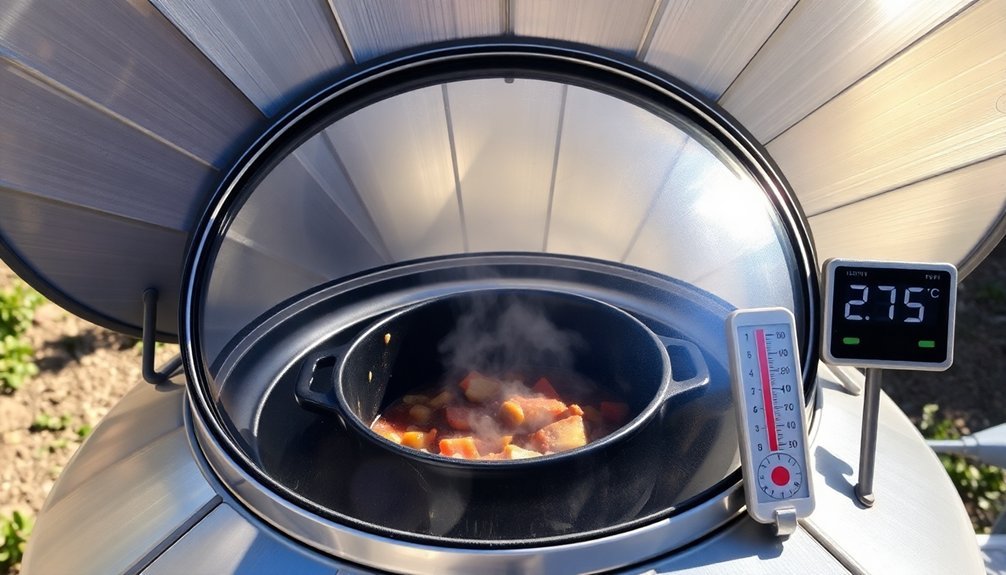Monitoring your meat's temperature while grilling outdoors guarantees both food safety and perfect results. You'll need to hit specific internal temperatures – 165°F for poultry, 160°F for pork, and 145°F for beef – to prevent foodborne illness. A reliable meat thermometer eliminates guesswork, helping you achieve your desired doneness whether you prefer rare, medium, or well-done. Modern wireless thermometers let you track temperatures from up to 500 feet away, so you won't need constant trips to check the grill. With today's weather-resistant tools and smart features, you can master the art of outdoor cooking with confidence.
Safety First When Grilling Outside

When you're ready to fire up the grill, safety should be your top priority.
Position your grill at least 10 feet from your house and 3 feet from deck rails, siding, and eaves. Choose a flat, level surface away from overhangs and trees.
Before lighting a gas grill, open the lid and check for leaks by applying a soap and water solution to the hose. If you detect a leak, turn off both the tank and grill immediately, and don't attempt to move it.
Remember to keep kids and pets at least 3 feet away from the grilling area, and never leave your lit grill unattended.
Keep a fire extinguisher nearby, and wear protective gear like gloves and an apron.
Clean your grill regularly to prevent grease buildup that could cause fires. Always use a meat thermometer to ensure your food reaches safe internal temperatures and prevent foodborne illness.
Perfect Doneness Every Time
Getting the perfect level of doneness in your grilled meats depends entirely on maintaining the right internal temperature.
You'll achieve consistent results every time by using a meat thermometer to monitor your food's temperature throughout the cooking process. Modern thermometers deliver instant readings in seconds to help you make quick cooking decisions. No more cutting into your meat and losing those precious juices!
Different cuts require specific temperatures – whole meats need 145°F while ground meats should reach 160-165°F.
With real-time monitoring, you'll know exactly when to remove your meat from the grill. Remember to let it rest afterward, as the temperature can rise slightly during this period.
Whether you're aiming for a rare steak or well-done chicken, your thermometer's precision eliminates guesswork and guarantees you'll get the ideal texture and juiciness you're looking for.
Keep Track From Afar

Modern wireless meat thermometers give you the freedom to monitor your cooking from impressive distances – anywhere from 150 to 500 feet away.
You'll get real-time temperature updates through a base station, wireless receiver, or smartphone app, eliminating constant trips to check on your food.
These wireless tools offer several advantages that'll transform your outdoor cooking experience:
- Monitor internal temperatures without lifting lids or opening doors
- Receive instant alerts when your meat reaches the target temperature
- Track both meat and ambient temperatures for consistent results
- Move freely around your property while staying connected
- Check readings easily at night with backlit displays
With water-resistant construction and long battery life, these thermometers work reliably in various outdoor conditions.
You can focus on entertaining guests or preparing sides while maintaining perfect control over your cooking process.
Some models like the ThermoPro TP971 offer 600-ft Bluetooth range for exceptional monitoring flexibility.
Multiple Meats Made Easy
Mastering the art of grilling multiple meats requires strategic planning and precise temperature control.
You'll need to space your meats 1-2 inches apart on the grill to guarantee even cooking and prevent cross-contamination. Start with a simple calculation: determine your target finish time and work backward based on each cut's cooking duration.
Begin with longer-cooking items like briskets or ribs, then add faster-cooking pieces later. You'll want to maintain specific temperatures for each type of meat – from high heat for steaks to low and slow for tougher cuts.
Keep your thermometer handy to check that each piece reaches its safe internal temperature: 165°F for poultry, 160°F for pork, and 145°F for beef steaks. Remember to clean your thermometer between readings to avoid cross-contamination.
Weather-Ready Temperature Tools

Reliable temperature tools remain essential for outdoor cooking, regardless of weather conditions.
Today's digital thermometers offer quick, accurate readings and can withstand outdoor elements while ensuring your food reaches safe temperatures. You'll find wireless options that let you monitor cooking progress from your smartphone, making it easier to manage multiple dishes simultaneously.
Key benefits of weather-ready temperature tools:
- Instant-read probes provide accurate measurements within seconds
- Wireless monitoring keeps you informed without standing by the grill
- Continuous temperature tracking prevents under or overcooking
- Multiple sensors track both surface and internal temperatures
- Mobile apps transform your device into a smart cooking assistant
These tools help you comply with food safety standards while delivering perfectly cooked meals, whether you're grilling, smoking, or BBQing in any weather condition.
Frequently Asked Questions
How Long Do Meat Thermometer Batteries Typically Last?
Your meat thermometer's batteries typically last 100-500 hours of continuous use, depending on the type. You'll get up to 300 hours from alkaline batteries, while lithium batteries can last 500+ hours of operation.
Can Meat Thermometer Probes Be Left Inside During the Entire Cooking Process?
You can leave probes inside meat during cooking, but it depends on your thermometer type. Oven-safe and probe-style thermometers are designed for continuous monitoring, while instant-read thermometers shouldn't be left in while cooking.
What's the Average Lifespan of a Digital Meat Thermometer?
You can expect your digital meat thermometer to last 1-2 years with proper care. However, if you're seeing unreliable readings, slow response times, or physical damage, it's time to replace it sooner.
Should Meat Thermometers Be Calibrated, and How Often?
Yes, you'll need to calibrate your meat thermometer monthly and after any drops or temperature extremes. Check accuracy using ice water (32°F) or boiling water (212°F) methods to guarantee safe, consistent cooking results.
Can Meat Thermometers Be Used for Deep Frying and Smoking?
Yes, you can use meat thermometers for both deep frying and smoking. They'll help you maintain proper oil temperatures (325-375°F) when frying and monitor both meat and pit temperatures during long smoking sessions.
In Summary
You'll guarantee safety and success by monitoring meat temperatures when cooking outdoors. It's not just about avoiding foodborne illness – you're also assuring perfectly cooked results every time. Whether you're juggling multiple cuts or grilling in challenging weather, a reliable thermometer lets you track doneness from a comfortable distance. Don't leave your outdoor cooking to chance when temperature tools make it so simple.





Leave a Reply